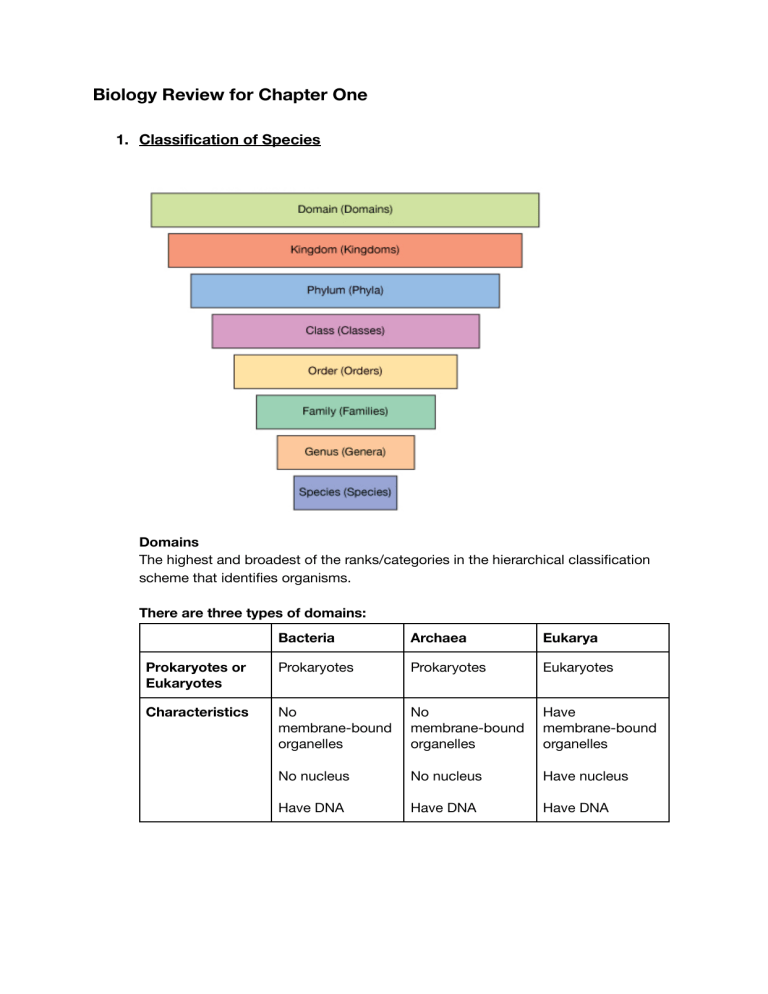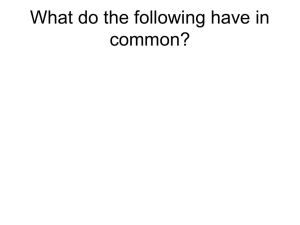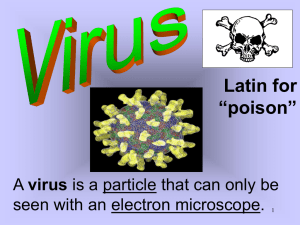Biology Review: Classification, Biodiversity, Viruses, Bacteria
advertisement

Biology Review for Chapter One 1. Classification of Species Domains The highest and broadest of the ranks/categories in the hierarchical classification scheme that identifies organisms. There are three types of domains: Bacteria Archaea Eukarya Prokaryotes or Eukaryotes Prokaryotes Prokaryotes Eukaryotes Characteristics No membrane-bound organelles No membrane-bound organelles Have membrane-bound organelles No nucleus No nucleus Have nucleus Have DNA Have DNA Have DNA Kingdoms: Is more specific than a domain and has fewer organisms The Eukarya domain is divided into four types of kingdoms Protista (Most diverse) Fungi Plantae Animalia Multicellular or Unicellular Mainly unicellular but some are multicellular Multicellular Multicellular Multicellular Nutrition Autotroph and Heterotroph Heterotroph Autotroph Heterotroph Has Cell Wall Some protists have cell walls (cellulose) Most contain cell walls (Chitin) Yes (cellulose) No Photosynthesis Some No Yes No Type of Reproduction Asexual and sexual Sexual Sexual Sexual Binomial Nomenclature The entire name must be written in italics The genus name is always written first The genus name must be capitalized The specific name is never capitalized Ex: Homo Sapien (scientific name for humans) Cladograms When the characteristic is above an organism, the organism lacks that characteristic Dichotomous Key 2. Biodiversity Types of Biodiversity 1. Species Diversity - Number of different species 2. Genetic Diversity 3. Ecosystem Diversity Importance of Biodiversity ● Biodiversity provides resources from plants, animals and trees which gives food, wood and medication. ● Increases the stability of species through the variety of traits within the ecosystem, thus enhancing the chances of survival. ● The variety of species also allows them to overcome disturbances when faced with changing their environments. ● Biodiversity also increases the productivity within an ecosystem. The greater the diversity is within an ecosystem, the greater the interactions are between organisms. More interactions mean more productivity and efficiency in the ecosystem. Measuring biodiversity Simpson’s Index: Human impact on Biodiversity ● Tree plantation ● Monoculture of livestock ● Overharvesting ● Overhunting ● Overfishing ● Use of pesticides ● Introducing Invasive species 3. Viruses ● ● ● ● ● ● A virus is an infectious particle that is non living All viruses are parasites and need a host Parasites live in or on other living organisms, causing them harm The host is the organism that the parasite lives on Plant viruses only infect plant cells Animal viruses only infect animal cells] Characteristics (living and nonliving) ● Viruses are extremely small. Most can be seen only with an electron microscope. ● When removed from a living cell, it ends all activities but keeps its ability to infect the cell ● A virus is active only when inside a living cell. ● Viruses have different sizes and structures, but all have one thing in common: - All enter living cells and use the cell to produce more viruses Living ● Can reproduce only inside a living cell ● Have DNA (double stranded molecule) or RNA (single stranded molecule) ● May have only four genes, or up to a hundred genes Non-Living ● Non-cellular ● No metabolism ● Can be crystallized, dehydrated and stored for a long tim Structures Capsid ● Is made up of proteins that allow the virus to enter the host cell ● Has a specific shape that must watch receptors on the surface of a host cell ● When the virus attaches to these receptors, the cell is “tricked” into letting the virus inside Reproduction 1. It attaches to the host cell 2. The genetic material (DNA or RNA) of a virus enters a host cell - Once inside, the virus reprograms the cell 3. The viral genome (haploid set of chromosomes) takes over the host cell and makes the host cell start producing viral parts instead of cell parts 4. The host cell assembles the parts into viruses 5. Thousands of viruses from the infected cell are released Two Reproductive Possibilities ● Some viruses replicate themselves immediately, killing the host cell ⇒ Lytic cycle ● Others replicate themselves in a way that does not destroy the host cell ⇒ Lysogenic cycle The Lytic Cycle ● A virus enters a cell, makes copies of itself, and causes the cell to burst 1. Attachment - Tail fibres are used to attach to receptor sites on the surface of the host cell. 2. Entry - Phage DNA is injected - Empty Capsid remains outside - Host cell DNA is destroyed 3. Replication (synthesis) - The host cell is directed to produce viral genomes and protein capsids 4. Assembly - Viral DNA or RNA is assembled inside the protein coat 5. Lysis and Release - The cell swells, bursts and releases hundreds of new viruses The Lysogenic Cycle 1. The virus enters the host cell 2. It mixes its DNA with the DNA of the host cell. The viral DNA is then replicated along the host cell’s DNA 3. The viruses do not kill the cell right away - May stay inactive for some time ✧Environmental Conditions may trigger a switch from the lytic cycle to the lysogenic cycle✧ Lytic Cycle Lysogenic Cycle Advantages Replication of the new virus is fast Many more viruses can be be made: viral genome is passed onto future generation of host cells Limitation Host is immediately killed, preventing the viral genome from being passed on to next generations of host cells Replication takes longer as it is dependent on the host cell’s replication Viroids ● Known for their simplicity and small size ● Much smaller than a virus ● Consists of small, circular molecules of RNA but have no capsid ● Tiny molecules of naked circular DNA ● Only been identified in plants Prions ● Type of disease-causing agent ● Lacks RNA and DNA ● Encourages other proteins in cells to fold abnormally - Build up of these proteins in the brain causes neural damage and death 1) Mad Cow Disease ● Aka bovine spongiform encephalopathy (BSE) ● Epidemics in the UK in the 1990's when cows were fed the remains of other cows; 160,000 cows ended up infected ● Humans were infected by eating beef mixed with braid tissue; called Creutzfeldt-Jakob disease 2) Kuru Disease ● A fatal neurodegenerative disorder caused by a prion - Spongiform brain ● Found among people in New Guinea who practiced a form of cannibalism Treatment of Viral Infections ● Viruses are not affected by any antibiotics ● Anything that will kill a virus will also kill the host cell ● Antibiotics are effective against bacteria but not against viruses ● Some treatments only slow down the reproduction of the virus, but do not provide a cure Vaccination ● Injection of a weak or killed organism that produces immunity against that organism ● Originated from the observations that scientist Edward Jenner noticed; milk maids exposed to a weaker cow’s pox never got smallpox ● When vaccinated, our immune system respond to the threat by producing antibodies to help destroy the viruses Bacteria ● Prokaryotic ● Asexual and sexual reproduction ○ Binary fission - replicate DNA and divides in half ○ Conjugation- a hollow bridge is formed between two bacterial cells. Through the tube plasmids move from one cell to another. ● Unicellular Archaebacteria ● Lacks peptidoglycan ● Have different membrane lipids ● Extremophiles - an organism that lives in habitats characterized by extreme conditions Eubacteria Similarities Archaebacteria Cell walls of peptidoglycan No nucleus or organelles Lacks peptidoglycan Cannot live in extreme conditions (Mesophile) Single celled Extremophile More standard energy production Prokaryotes Less standard energy production Evolved from a common ancestor Shapes 1. Bacillus (s) Bacilli (p) 2. Coccus (s) Cocci (p) 3. Spirillum (s) Spirilla (p)




